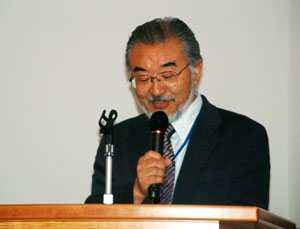Kazuo OIKE

Good morning ladies and gentlemen.
Dr. Lawrence Loh, Secretary General of Association of Pacific Rim Universities, all participants of member universities of APRU and Association of East Asia Research Universities, AEARU, and ladies and gentlemen, I would like to express my deepest thanks to all of you who have come to attend this APRU/AEARU Research Symposium on “Earthquake Hazards around the Pacific Rim - Prediction and Disaster Prevention - “.
I welcome you all to Kyoto University Centennial Memorial Clock Tower.
Kyoto is a very peaceful place, and it is world famous for its many serene temples and beautiful gardens. During your stay, I hope you have a chance to visit some of these places, such as the nearby Ginkakuji (Silver Temple) where you can see the simple and elegant style garden and the nearby Shimogamo shrine which is one of the 17 world heritages in Kyoto City.
However peaceful Kyoto is now, as all of Japan, the city has had violent earthquakes in the past. The Kyoto basin, with its surrounding mountains is formed because of surrounding earthquake faults. One of these is the active Hanaore fault, which is just one hundred meters to the east of where you are now sitting. If you walk to the Yoshida shrine on the edge of the campus, you can walk up the stone stairs that are on the slope formed by the fault scarp. The last major earthquake on this fault is estimated to be about 1500 to 2000 years ago.
Once in a while we feel small tremors from this fault, which reminds us that there is always the possibility of a large earthquake. However, if a large earthquake happens during this meeting, you should be safe within this recently retrofitted building. The clock tower was retrofitted with seismic dampers, and designed to withstand severe horizontal shaking, such as if the Hanaore fault were to shift, or is a magnitude 8.5 Nankai earthquake happens. Later this week you will be shown the seismic dampers in this building and walk along the Hanaore fault.
Three years ago the ministry of education, science, technology, culture and sports in Japan, started a new program of Centers of Excellence for the 21st Century. These are competitive grants given to universities for research and education on specialized topics. Kyoto University has 23 COE programs, which cover fields such as, Sustainable Energy, Biodiversity, Genomic Analyses and so on. Two of the COE programs are related to earthquakes, and have contributed to the organization of this symposium.
The Kyoto University Active Geosphere Investigations (KAGI21) , in the graduate school of science is studying a wide range of geophysical fields. This program is looking at integrating geophysical studies, and includes many disciplines that study the Earth from atmosphere and ocean flow, down to the matter of the solid earth (including earthquakes) . KAGI21 holds an international summer school for graduate students. And in July 2004, I participated in the summer school that was held in Indonesia. There were students from Indonesia and about 20 other countries. This was just a few months before the catastrophic Sumatra earthquake. We talked about earthquakes, volcanoes, global warming, and how large scale geophysical phenomena of the Earth affect our society. I was impressed with the enthusiasm of the students from countries such as, Indonesia, Thailand, Malaysia, Australia, China and Japan. There is no lack of potential and energy in our young people to tackle the important problems of earthquakes, and APRU should look for ways to focus this energy of the students, into meaningful research. At this symposium we have encouraged student participation and are pleased to display quite a number of student posters in the room next door.
Bandung Summer School Attendance
Another COE program at the Disaster Prevention Research Institute of Kyoto University, is the '21st Century Center of Excellence forNatural Disaster Science and Disaster Reduction(External Link)'. This COE program is dealing with the causes and solutions of a wide variety of natural hazards. Japan is a small country with many people, and unfortunately has more than its share of natural hazards in addition to earthquakes. There are active volcanoes, typhoons, floods, and landslide hazards. Last year in addition to earthquakes, it was one of the worst years for typhoons, with 10 severe storms that reached land fall. There were over 200 deaths and over US 7 billion dollars of damage from the winds, flooding, and associated landslides. Luckily, last year we did not have any significant volcanic eruptions. Members of this COE program have had a busy year with field investigations following typhoons, flooding, landslides, and earthquakes in Japan. Also there was a tsunami field investigation following the Sumatra earthquake, which you will hear about later in this meeting.
During your stay in Kyoto, I hope there are no large earthquakes, typhoons, nor landslides, so you can enjoy the peaceful aspects of Kyoto basin. The beautiful area to the east of the campus is the location of the famous Philosopher's Walk. Strolling along this path is supposed to inspire great thoughts. It is said that the beautiful scenery of Kyoto City which was originally created by the tectonic forces of earthquakes, is home to the famous philosophers and Nobel Prize laureates from Kyoto University.
Since many of you have traveled a long way to Kyoto, I hope that the trip will be worthwhile for you and that you have a productive and enjoyable time at this symposium.
Thank you very much.

